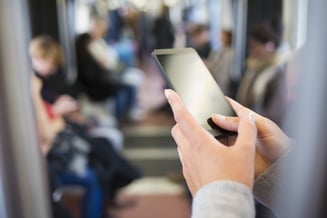
How Has Rail WiFi Technology Developed? | WiFi SPARK
Recent research found that the average commuting time in the UK has risen from 48 minutes to an hour and that one in seven commuters are now spending two or...
Read more
4 minute read | 22/11/2018

In the most recent NRPS figures, 50 percent of those asked labelled WiFi services on trains as being poor. Passengers are frustrated with limited connectivity and regional blackspots. In this blog, we’ll discuss how to approach these issues and if there’s an ultimate transport WiFi solution available.
Passengers can have an excellent internet connection on their devices while waiting in the station and for the first stretch of their journey, but can become frustrated on longer travels as it drops or becomes unreliable.
It’s unlikely that network providers will install new masts in rural areas as it isn’t commercially viable for them, so blackspots are an issue that won’t be going away anytime soon.
Because of this, there’s no quick fix to improve the connectivity on trains. What Train Owning Groups (TOGs) can do is look for ways to be more transparent and open about WiFi connectivity problems and ensure that / is as good as possible and offers data offloading to and from trains.
Passengers are less likely to be frustrated with the WiFi if they can maintain their session from station train and beyond, as well as if they know beforehand that they’re travelling through a blackspot. One idea would be to include WiFi signal strength as part of passenger information.
A traffic light system could be used to indicate exactly where in the journey the connection is poor. As an example, it could be green for the first hour that has good connectivity, but then red for the last half an hour where it's poor. If the passenger knows this beforehand, they can make sure they don’t need to use the internet for anything important during this section.
If implemented, this would be a significant step forward for passenger satisfaction.
Some network providers that supply station and onboard WiFi keep the data that’s collected from the service. This data is incredibly valuable and if this is the case for your solution, you could be missing out on a fantastic opportunity to gain valuable insight into passenger habits and preferences.
With this data, you can make changes to the services that you offer that will improve passenger satisfaction and revenue. For example, you’re able to know which routes leave passengers with the longest dwell time. By knowing where they spend the most time, you can promote relevant concessions in that area and increase sales.
In addition to dwell time in the station, this data can also give you insight into which train the passenger moves onto, which station they get off at and what percentage of passengers use other services like the metro or a bus.
With this data, you can upsell your other services. You can think about introducing certain advertising or marketing campaigns as a way of increasing brand awareness as you know rail passengers will see it.
It isn’t new or innovative for a train or train station to offer passengers a WiFi connection. It’s something that visitors expect when they arrive. But, simply offering WiFi isn’t enough, so a great way of making sure your service has the wow factor is to provide a library of entertainment content.
Passengers use the WiFi for all kinds of purposes, whether it be checking work emails or messaging friends. However, once they’ve done that, there might be hours left of their journey so they’ll appreciate having free access to content to relieve their boredom.
Some providers offer the latest TV shows and films for free for all passengers. They’re able to catch up on the daily newspapers and even play games to keep the kids busy as they travel.
There are a number of media alternatives available to consider. Whichever you choose to implement, offering free on-board entertainment improves passenger satisfaction and helps their journey to fly by.
Just having the WiFi available on trains and in stations isn’t enough for the modern day commuter. They’re used to connecting to the WiFi at home, in the pub and in hospitals, so when travelling by train it should be no different.
What can be frustrating for passengers is having to deal with multiple logins throughout their journey. They might be asked to create an account when they first arrive at the station but have to keep signing in at regular intervals. Passengers expect to be connected in the station, on the train and on any further transport service without having to worry about logging in again and again.
Consider a service that offers this data offload, allowing users to have a continuously connected passenger journey, that offers passengers this single connection as well as maintaining your brand image.
It’s clear that there isn’t any one ultimate transport WiFi solution that can resolve all issues across the board. But with some of the changes mentioned in this blog, TOGs can begin to use their WiFi to improve the services they offer.
If you’d like information on continuously connected passenger journeys and want to know more about how TOGs can maximise their WiFi service, download our free eBook. It features the benefits of a platform-to-platform WiFi offering and how it can improve different areas of your business.
Click on the download link below to receive your free copy of the eBook.
(the Continuously Connected Passenger Journey- UK Patent 2556060)
Rebecca is the Marketing Director. She's worked for SPARK TSL since 2012. She is responsible for high level marketing strategy focusing on lead generation and aiding the vision of the business; to ensure that no patient has to pay for entertainment.
More articles by the author

Recent research found that the average commuting time in the UK has risen from 48 minutes to an hour and that one in seven commuters are now spending two or...
Read more

While airports have always been used to flog perfumes, sweets and luggage to a captive audience, train station operators have been much slower to make the most...
Read more

When working through budgets or writing business cases for Transportation, services like WiFi may not be a priority on the to do list. Questions like “Is there...
Read more